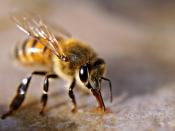ÃÂThe Buzz on BeesÃÂJeffrey Kluger & Kristina DellTime Magazine 29 October 06Scientists have mapped out the genome of yet another organism and what better insect to study than our busy little worker friend, the bee. Their genetic map is being researched at the moment in hopes of understanding this valuable insect. Why study bees you ask? First of all, mapping out genomes helps scientists in their quests to one day map out the human genome. Second, the bee population has been cut in half in the last fifty years. Studying a beeÃÂs genetic map will help us to keep it (and possibly us) from extinction.
Three main factors have are responsible for the dramatic loss in bees. First, the Varroa mite (first spotted in the U.S. in 1987) kills adult bees but more importantly, kills larvae and eliminates a generation of bees before theyÃÂre allowed to reproduce. Tracheal mites (first spotted in U.S.
in 1984) go for the respiratory system of the bees and can kill of an entire hive in a couple of hours. Also, due to the beeÃÂs weak immune system, pesticides caught in the wax of hives completely obliterate them.
The main reason scientists are concerned with the decline in numbers is that bees are responsible for pollinating 30% of food in the U.S.. Some fruits are produced in the billions of pounds due to bee pollination to include oranges and grapes. They even pollinate alfalfa, which is used to feed cattle. In other words, if bees continue to decline in numbers, we will take a large loss in our food supply. It may drive some plants that depend on bees to extinction.
What weÃÂve learned from the bees anatomy and genetic make-up is that first, itÃÂs brain is smaller than a period on this page.


